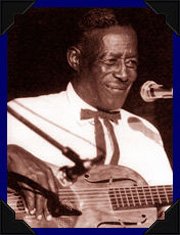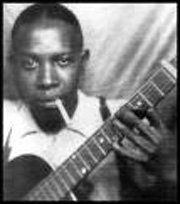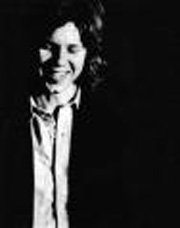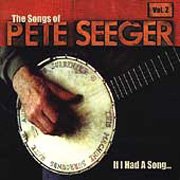Mississippi
John Hurt
Learn to play in the style of MJH, original early country blues roots music.

He has influenced an innumerable amount of musicians throughout the last four decades. His songs continue to be played throughout the world.
He invented the alternating bass style of fingerpicking.
"I just make my guitar sound like the way I thought it should."
Blind Willie Johnson
Learn
the scintillating slide licks of Johnson. He started using
a pocket knife for a slide
to mimic his voice.

He had the power
to make a religious song sound like the blues and a blues song
sound holy.
He sang in a
"rasping false bass," and played bottleneck guitar with "uncanny
left-handed strength, accuracy and agility."
Blind Willie played mostly in open D tuning using the alternating bass method while playing the melody predominantly on the first string with the slide.
"Dark
Was The Night Cold Was the Ground is the most transcendent
piece in all American music."
Lightning Hopkins
Once he was
playing, he would almost slip into a trance and a blues stream
of consciousness would come pouring out, making him nearly
oblivious to what was going on around him.

Hopkins had a bag of licks and patterns that
fit largely into two divisions -- slow E and Fast E (with an
occasional venture into A). He along with other Texas blues
guitsrists including Mance Lipscomb specialised in the monotonic
bass style.
Son House
Born near Lyon, Mississippi, March 21, 1902, Son House chopped cotton as a teenager while developing a passion for the Baptist church.

His song "Preachin' The Blues Part I & II" was a six-minute biography of his life and served as inspiration for Robert Johnson's "Preaching Blues" and "Walking Blues".
" House's powerful vocals and slashing slide guitar style established him as a giant of the Delta School."
Robert Johnson

Robert Johnson is renowned as the legendary King of the
Mississippi Delta Blues.
Johnson was not gifted with a musicial talent for guitar.
According to A.W.Miller, the legendary Eddie "Son" House taught
Johnson to play. House taught Robert the basics of blues. House
really encouraged Johnson to take his music seriously and to go
for his goal and become a professional musician.
Around June of 1930, blues musician Son House came to Mississippi. His music deeply affected Robert Johnson, for it was the "rawest, most direct pure emotion Robert had ever heard, and he followed House and [Willie] Brown wherever they went"
Nick
Drake

Drake is known for his gentle, autumnal songs and his virtuoso right hand finger picking technique. Although he recorded only three albums, critics and fellow musicians held his work in very high esteem. Other outstanding British Folk guitarists include, Bert Jansch, John Renbourn and Davy Graham.
Doc Watson

Doc Watson has had a profound influence in the areas of traditional folk, country blues & bluegrass. His finger picking, flat picking, banjo playing and vocal skills are second to none. He was arguably the greatest ever acoustic guitarist.
Pete Seeger

Learn
the banjo style of Pete Seeger who mastered and internalised
great American folk traditions.
Pete Seeger was born to a musicologist and a music
teacher. Music and activism blended naturally for Seeger
"I fell in love with the old-fashioned five-string banjo, rippling out a rhythm to one fascinating song after another."

Learn the scintillating Indian slide as played by the legendary Vishwa Mohan Bhatt.
Underpinning this slide technique is the approach of Indian music which captures the subtle moods and emotions of the human condition through the expression of ornamented slide.
Robert's sense of timing and pitch was second to none. He moved freely from swing time to straight time and visa versa even within the one phrase.
His ability to improvise and to connect to his spirit as troubled
as it was, was exceptional.
Listen to the two recordings of Crossroads and observe how the
second take recorded immediately after the first is
completely different.